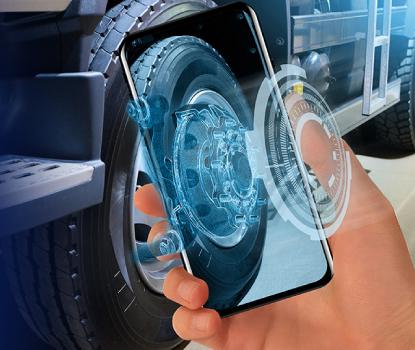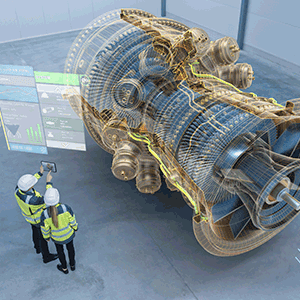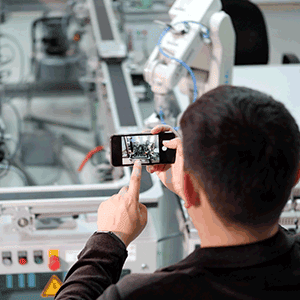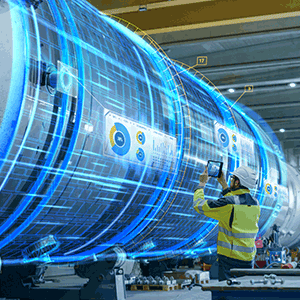Tag: Digital Innovation
What considerations should be part of a company’s digital transformation strategy?
Smart business leaders are waking up to the fact that they need to get digital transformation “right” for their very survival. The widespread adoption of technology, rapidly changing consumer behavior, and innovation-triggered disruptions are making digital transformation a must-have for businesses.
In a recent survey by Gartner, 87% of senior business leaders responded that digitalization is a company priority and 79% of corporate strategists said that digital innovation is crucial for reinventing their businesses.
It’s clear that organizations have started thinking about digital innovation. What they need to know next is the best approach to start, lead change, and transform.
In this interview, our Senior Vice President – Process and Technology, Deepu Prakash shares his expert opinion by answering these questions:
- How do you define digital transformation?
- What does digital transformation mean to your company?
- How can a brand identify what digital transformation should mean to them?
How do you define digital transformation?
Digital transformation is the strategic, deliberate, and sustained application of modern digital technologies to deliver highly unique customer value propositions, by making fundamental changes to how a business operates.
Can you explain what digital transformation means to your company?
I look after the process and technology practice at Fingent. To us, digital innovation broadly means three things.
1. Strategic shifts
Our focus has shifted from developing products to developing platforms, both for us and for our customers. We are moving away from a value chain-based model towards managing the entire ecosystem that impacts our customer base. Today, we are on the constant lookout for partnerships that can help us provide a competitive difference to our customer base. We expect cross-industry consolidation in the near future.
Related Reading: Why Business Leaders Must Embrace Digital Adoption
2. Developing operational agility through digitally-enabled processes
We are using digital technology to cut across organizational and departmental silos to provide a better Customer Experience. This results in increased cross-department and cross-organization project management, collaboration, and integration. We are reorganizing our processes to enable experimentation and evidence-based scaling.
From a technology perspective: DevOps practices, APIs, and Unified Identity management are being rolled out across the organization. We are setting up practices to actively leverage third-party developer innovation, to reduce the time-to-market for us and our customers. In fact, one of our products INFINCE is empowering small businesses to achieve digital agility without the need to own infrastructure or an IT practice.
3. Culture and competence:
Despite being a young technology company, we have to work hard to develop the mindset needed to adapt to the massive technology shifts, across all departments. While training helps, it takes continuous coaching and mentoring to help deal with the culture shock that such transformation brings in. Roles and job descriptions may not be so clearly defined as it used to be before. Hence, there is less certainty around outcomes and an increased need for greater transparency than what we had previously.
The ability to exert influence without direct authority is a critical skill for career growth.
How other brands can identify what digital transformation should mean to them?
- Successful digital transformation is less about technology and more about leadership. Hire the right leadership talent to create a digital transformation strategy that would work for your customers and your people.
- Start by deeply re-examining your core business through your customers’ eyes. Ask yourself whether your business will continue to stay competitive or will it be sustainable going forward.
- Map out the entire set of customer journeys. Include customer interactions with your allied products and services. Map modern digital technologies to all these journeys. Identify new channels, new opportunities, and see how you can reach out through all these channels.
- Analyze your state of competition not just with the established players, but also with the startups in your industry segment and adjacent segments, especially with a view to identifying the relevant technologies, platforms, and vendors.
Related Reading: 4 Questions to Ask When Your Business Goes Digital
Need help with your digital transformation goals?
Fingent’s team is highly experienced in helping businesses solve their digital transformation challenges.
We have partnered with businesses worldwide in their digital transformation projects.
We can help you define your vision and create robust digital transformation plans that enable your business to transform and grow. To take advantage and get the ball rolling, please get in touch with Fingent top custom software development company.
Stay up to date on what's new

Featured Blogs
Stay up to date on
what's new



Talk To Our Experts
Stay up to date on what's new

Featured Blogs
Stay up to date on
what's new



Talk To Our Experts
Digital Adoption is crucial for the success of an organization. Businesses understand this and are going full steam ahead in ensuring that they are completely equipped digitally. While the IT department is primarily hands-on with digital adoption, it is becoming increasingly clear that business leaders must also roll up their sleeves and get involved with the digital goals of the company. This blog will discuss why this is important and how it makes for better business leaders.
Digital Adoption
Digital adoption in the most elementary sense is to achieve a state of functioning where all the organization’s digital tools are used to their full capability. Digital Adoption also involves getting stakeholders, including customers and employees, to use these tools to the best.
If the company has a whole repertoire of digital tools, it doesn’t mean that they have successfully implemented digital adoption. It can only be a success if these tools are being used to their full capacity by the organization and its customers.
How Digital Adoption Makes You A Better Business Leader
Talking about the top executives in today’s organization, Dion Hinchcliffe, VP and principal analyst at Constellation Research says that they must “match the pace of change, fall behind, or lead the pack.” Continuing on what is expected of business leaders particularly the CIO’s today, he says: “That’s the existential issue at stake in today’s digitally-infused times, where bold action must be actively supported by out-of-the-box experimentation and pathfinding … The CIO this year must be both a supremely masterful priority juggler and an effective digital leader from the front.”
This is what today’s business scenario demands a true business leader. Leaders are expected not only to be digitally informed but to be able to lead their company into digital transformation. Digital adoption must be the focus of their efforts. Here are a few ways in which digital adoption can make you a better business leader.
Related Reading: Find how digital innovation is transforming today’s business.
1. Leading Change and Growth
One of the qualities that define a capable business leader is his ability to be a visionary and lead his organization towards growth. In today’s world, growth is becoming synonymous with the company’s ability to keep up with technology and digital transformation. Business leaders stand to benefit the most as their company moves forward and adopts the best of digital technology.
And yet, according to a KPMG study, more than 56% of digital initiatives fail due to lack of leadership. As this shows, good leadership can make all the difference between success and failure of digital adoption. The mindset of a leader and his/her dedication to digital adoption will direct the mindset of the rest of the organization. Digital disruption calls for a positive attitude towards change. It calls for a change in the culture of the organization. Encouraging innovation and experimentation is also key to the success of digital adoption. All this can only be achieved if the CEO and top-level management embrace and lead the change.
2. Gaining Customer Insight
Today’s business is more customer-centric than ever. The success of an organization is dependent on its understanding of customer preferences and behavior. In the digital age, there is no better way to gain customer insight than through digital adoption.
Jim Swanson, former CIO of Monsanto is an excellent example of leaders who leverage a company’s IT to deliver growth and value in the business. Discussing digital transformation in terms of customer centricity and the role of leaders, he says: “We talk about automating operations, about people, and about new business models. Wrapped inside those topics are data analytics, technologies, and software – all of which are enablers, not drivers. In the center of it all is leadership and culture. You could have all those things – the customer view, the products and services, data, and really cool technologies – but if leadership and culture aren’t at the heart, it fails. Understanding what digital means to your company – whether you’re a financial, agricultural, pharmaceutical, or retail institution – is essential.”
That is where the magic lies. Understanding digital and understanding what digital can do for your customer-centric goals is where you will find success. When business leaders understand this vital concept and become champions of digital adoption, then the company will see real growth.
Related Reading: Find how machine learning boosts customer experience.
3. Nurturing Curiosity
Curiosity is an important attribute of growth and change. To step out of their comfort zone and embrace growth, business leaders must cultivate and foster this important attribute. In a PWC survey of 1,322 CEOs in 77 countries, most CEOs pointed out to the importance of being curious. In order to keep up with the turbulent business scenario and stiff competition. Michael Dell, Chairman and CEO of Dell, says in the report: “The one attribute CEOs need in the future to succeed, that I would place my bet on, is curiosity. From curiosity comes learning and new ideas. In businesses that are changing very rapidly, if you’re not curious, if you’re not learning, if you don’t have new ideas, you’re going to have a real problem.”
Curiosity plays a vital role in embracing digital technology and helping employees adapt to change. Fostering a culture of innovative thinking and intellectual curiosity will help the organization move forward with digital adoption and make the best of it. Conversely, digital adoption will help business leaders build curiosity and lead their organization towards innovation and success.
Embrace Digital Adoption
The importance of embracing digital adoption cannot be overemphasized and it must start from the top. It has been estimated that there will be US$15.7 trillion in global GDP gains from AI and digital by 2030. If you want to rake in some of this revenue, there are no two ways about it – go digital or go home is the verdict! Fingent helps business leaders worldwide in their journey towards digital adoption and transformation. Let’s have a chat and see what we can do for your business.
Related Reading: Check out how AI is driving business value across industries.
Stay up to date on what's new

Featured Blogs
Stay up to date on
what's new



Talk To Our Experts
Digital revolution has not just changed how businesses are perceived but also how businesses are performed. It meant a shift from the conventional means of operation to the one aided by technology. In today’s age, every aspect of a business from operations to management is run using digital tools. Such digital transformations has changed every industry and revolutionized the way of serving the customers, improve the competitiveness of the business and pushed forth its expansion into the global market.
Coleman Parkes Research in one of their surveys identifies that 82 percent of respondents have adopted digital technologies for redefining their businesses. This complete overhaul of business with the reinvention of business operations are affected by the advent of mobile, cloud, social, and big data analytics. So has the transcendence of a digital world helped grow businesses? If yes, what are the ways in which businesses can take advantage of the same?
Related Reading: Implementing a digital transformation strategy for your business requires adequate know-how of the varied process involved in the same. Know about the five crucial questions to consider before initiating your digital transformation journey here.
What are the innovative changes?
Early on, businesses built websites as a front for providing only information. With interactivity and the onset of the mobile revolution, sites and apps started to provide much more. They are used to offer services and products right at the doorstep of customers. The use of social media has enhanced the knowledge regarding what the customers like and what they seek. Businesses can use this medium to understand and tailor personalized experiences to provide real value to their customers.
Big Data analytics has changed the way businesses adapt and change. From decision making to predicting customer preferences and hiring the right skill sets, big data analytics has emerged as the game changer for businesses today by influencing how they deal their data. Instead of undertaking a market study, there is relevant data that tells what is working in the market and what is not.
The competitiveness
Each business that enters into a digital transformation is out there to compete every second. Imagine the new generation of customers who have everything at the tap of a button. Businesses need to be on their toes to deliver rich, real-time interactions with an element of personalization to keep their customers engaged. Also, the need to keep updating and innovating with respect to the competition is a necessity to save the business from running into the ground.
Read more: Fundraising Software For Nonprofits
The increased reach
Even though the competition increases with the digital transformation, businesses can take advantage of the fact that now they have reached a global audience. There is a market for the niche of products and services since customers have a way to access them easily. Also putting a step into innovation ensures that your business is at the forefront of achieving a profitable chunk out of the industry.
Improved avenues
Since transforming the business into a digital space is no longer an option, businesses should start utilizing the benefits of such a change. Pervasive digitization of services and products can be made to ensure that there are no barriers between the business and their customers. Also, traditional companies can start making efforts to revamp or add new services that are digitally available to increase their profits. Monetization from digital platforms and collaborations with partners can further help achieve better profits from an untapped source of customer relationships.
Related Reading: Take a look at the CIO’s opinions of digital transformation initiatives deployed across different businesses here.
How to make the most of this digital transformation?
In today’s day and age, no business is smaller or bigger, each of them competes in a virtual, digital space that offers fair ground for competition. Businesses should start looking at Big Data analytics and use the social media space to push their content to the customers. The idea is to be always supple, no matter how big or small your business is. Think like a startup at every step to understand the new technologies, the revolutionary changes, and be flexible to adopt them quickly. Having a digital core at the heart of your organization to manage and operate the business is the right way to go ahead in this modern digital era.
If your business is seeking to get into the race of digital transformation, it is important to act right now. Late adopters can have serious disadvantages since the competition is already in the domain. If you are looking to adopt a business model that utilizes a digital core, Fingent top custom software development company can help you to embrace the digital transformation with the best developers to get to the forefront of change.
Stay up to date on what's new

Featured Blogs
Stay up to date on
what's new




































































